Pretend you only have enough money in your pocket to buy one book. You start browsing through all the titles on Amazon and narrow it down to two choices.
The first one has this next to it:

The second one has this:
If you’re like most people, you would pick the first choice hands down. It has 1,206 people vouching for it and 4.5 stars, while the second one only has 3 people who gave it the same review.
Now, what if it was between the second choice (with an average 4.5 star review from 3 people) versus a book that had no reviews?
In that case, the one with 3 reviews looks more favorable all of a sudden. You’re not going to want to take one for the team and risk the only money you have on an “unproven” book.
This is what social proof is all about.
You follow the wisdom of the crowd as a shortcut to find the correct answer to a situation. It works when you’re in a new city for one night and looking for a place to eat on Yelp. It works when a friend recommends a new phone to you. And it can work for your online business, too.
Having social proof on your website can singlehandedly determine whether someone lands on your site and hits the back button, or signs up for your email list. It can mean the difference between a buyer and a non-buyer. And most importantly, it can determine if you’re perceived as someone credible, or just another quack with a blog.
In this post, I’m going to cover 4 types of social proof that GrowthLab students have used to launch six-figure businesses, get featured in national press, and build communities of loyal fans.
Add them to your site and watch your business become the trusted, go-to place in your industry.
Social proof type #1: High-level endorsement
Big brands like Nike love to use the high-level endorsement. They inked a deal with Michael Jordan back in 1984, and throughout his career, they became a billion-dollar company.
Which is why it was a no-brainer for them to sign a lifetime endorsement deal with LeBron James that’s rumored to be worth over $1 billion.
A single high-level endorsement can take your business from obscurity to the limelight almost overnight. Luckily you can use high-level endorsements for your business without shelling out the big bucks and having to deal with agents and contracts.
Let’s take a look at how Charlie Hoehn does it.
He’s a younger guy who gives career advice. It’s hard to believe he has a ton of experience just by looking at him.
So he overcomes this objection by using a high-level endorsement.
Go to his site and you’ll see this:

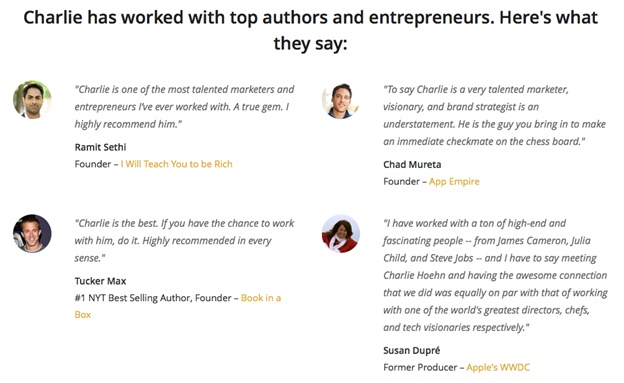
These are all names that people in his audience are familiar with. The fact that they’re all singing praise for him is social proof in the form of a high-level endorsement.
What’s more amazing is that Charlie directly worked for all these people. So it’s instant credibility for his career advice. His narrative is basically saying, “I got all these great career opportunities, now I’m going to show you how to do it.”
So how do you collect high-level endorsements if you’re starting out?
First off, I want to make it clear that high-level endorsements are all relative. Yes, everyone knows who Oprah is. But Charlie’s endorsements, while very popular in certain circles, are virtually unknown to outsiders.
So you don’t need to hunt down a big name just so you can add this social proof to your site.
In fact, a job or freelance work is a good place to start in collecting this.
If you’re a marketer working for a Fortune 500 company, getting a stamp of approval from the VP of Marketing can serve as a strong high-level endorsement. If you’re a web developer who got a freelance gig with a popular ecommerce site, praise from the Director of Ecommerce can be your high-level endorsement.
The trick to getting these endorsements is to simply add one more step in your project process.
Whenever you complete a project, email the person in charge for feedback. If everything went well, people will be in good spirits and you’ll get responses like, “You did an amazing job!” The next step is to ask if the other person would be okay if you used that as a testimonial.
99% of the time they’ll say yes.
Then you can simply forward all these emails to your personal email account and put them in a folder called “Praise” or whatever you want. That way you don’t have to go hunting for them later.
If people verbally congratulate you on a job well done, ask if it would be possible to have it in writing. Heck, even offer to write it up for them so then all they need to do is make any edits and sign off.
Here’s an example of a script you can use:

Boom! After a few months, you’ll have a pile of high-level endorsements.
Wish you could connect with more amazing people, and not feel awkward in social situations? Download our FREE Ultimate Guide To Habits below.
Social proof type #2: Customer testimonials
If you’re selling a product or a service, the best way to add social proof to your site is to show results that others in your target audience have achieved by using testimonials.
For example, take a look at these:
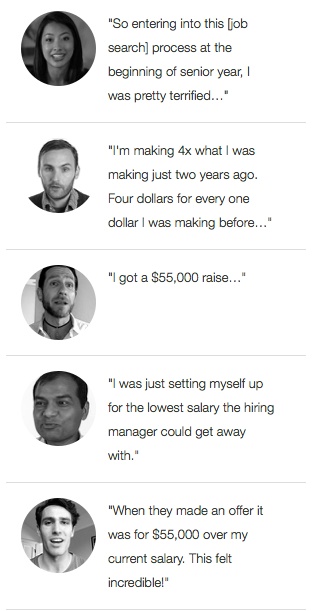
These are for IWT’s Dream Job course where the typical buyer is someone in their 20s or 30s. If this were a job-seeking course for executives, you’d probably see older folks.
That’s the important part. People want to see that others — just like them — have gotten results. Which is why you don’t want to ask friends or family for goodwill testimonials. Unless they’re in your target market, your message will be diluted. And you won’t get the social proof you were looking for.
The easiest way to put collecting testimonials on autopilot is to use a survey whenever you work with a client or after someone uses your product.
You can create a free account on Survey Monkey in less than 5 minutes. Once you’re signed up, you can simply use their customer satisfaction template:

Add two questions at the end to collect testimonials like this:
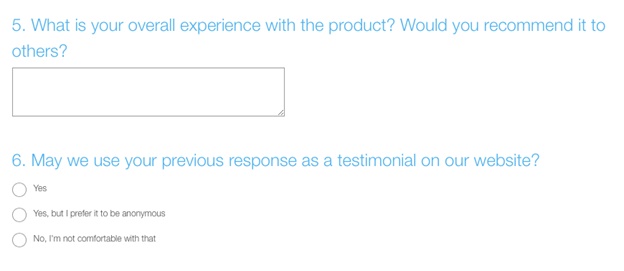
The key is to make the overall experience question qualitative. You want people to write their honest reviews. Then you ask them for permission to use it.
Adding this step to the end of any project makes the process of collecting testimonials easy. And it cuts the hassle of chasing after people a year later and following up.
Bonus tip: Sites like Amazon and Etsy let people write reviews for purchases. If you’re selling a product through these marketplaces, all you need to do is screenshot a few good reviews and you’ll have testimonials for your site.
Social proof type #3: Press mentions
As we’ve said before on GrowthLab, guest posting is a great way to grow traffic and boost your email subscribers. It’s also a great point to leverage as social proof.
The fact that you’ve pitched these sites and they accepted your posts means you are no longer a random blogger. You’re seen by the general public as someone who is knowledgeable and credible now.
A blogger on Huffington Post — a site that gets millions of readers a day — is seen as more legit than someone with a random blogspot site. The public perception is that editors and people who manage the site have vetted the contributing writers on behalf of the readers.
So as soon as you have a few guest posts or interviews under your belt, you’ll want to add those as social proof. These basically tell your site visitors, “Hey, this person is kind of a big deal!”
You’ve probably seen those fancy banners on sites like this:

If you have the design skills to pull it off — great. If you don’t, there’s no need to worry.
Penelope Trunk runs an extremely popular blog and doesn’t have any fancy banners like that (at least I couldn’t find any).
She simply lists her press appearances in her bio.
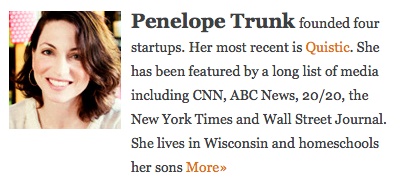
Also, remember this: If you were ever mentioned or quoted in a major publication, like Forbes or Fast Company, even if it was just one line, you can forever say that you were featured there.
Milk that for all it’s worth. Add it to your site as social proof.
Social proof type #4: Safety in numbers
As I said earlier, people love to follow others when making quick decisions. That’s what social proof is all about. Nowhere is this more apparent than with the herd mentality.
- The restaurant with the longest line must be good, so it’s worth the wait
- Picking a book from the bestseller list is a sure-fire bet
- People love to be members of clubs — the more exclusive the better
People find safety in numbers. The thinking is that “all these people can’t be wrong.” Whether that’s true is another discussion altogether. The point is, if you have an impressive number of customers or email subscribers (1,000+), you can leverage that as social proof.
That’s exactly what Ryan Holiday does for his email list:

He doesn’t ask you to just sign up for his email list. He asks you to “join 40,000+ subscribers.”
A person sees that and thinks, “If that many people are on his list, it must be good. I’m in.”
The best way to put this to action is to simply set it and forget it.
- MailChimp has a widget that counts your subscribers and displays them as social proof.
- AWeber also has a way to add subscriber count to your site.
If you haven’t been actively courting social proof for your site, today is the best day to start.
Once you have these 4 types of social proof, you can combine them to create the ultimate homepage that screams credibility.
That’s exactly what Grasshopper — a phone service for entrepreneurs and small businesses — did.
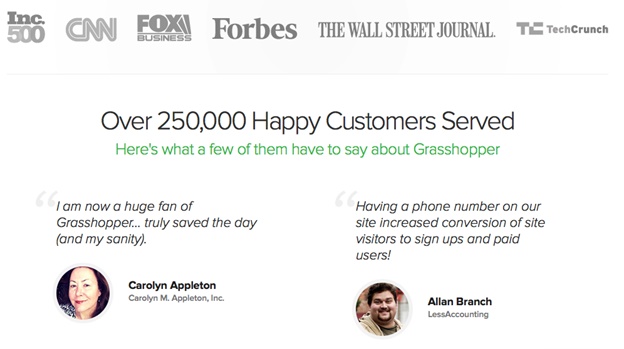
As a potential customer going to their site, it’s easy to feel like you’re in good hands by signing up for their service.
Which is why it’s important to not neglect social proof. It’ll only take an afternoon of your time to add these elements for your site. But it’ll pay you many times over for years to come.
